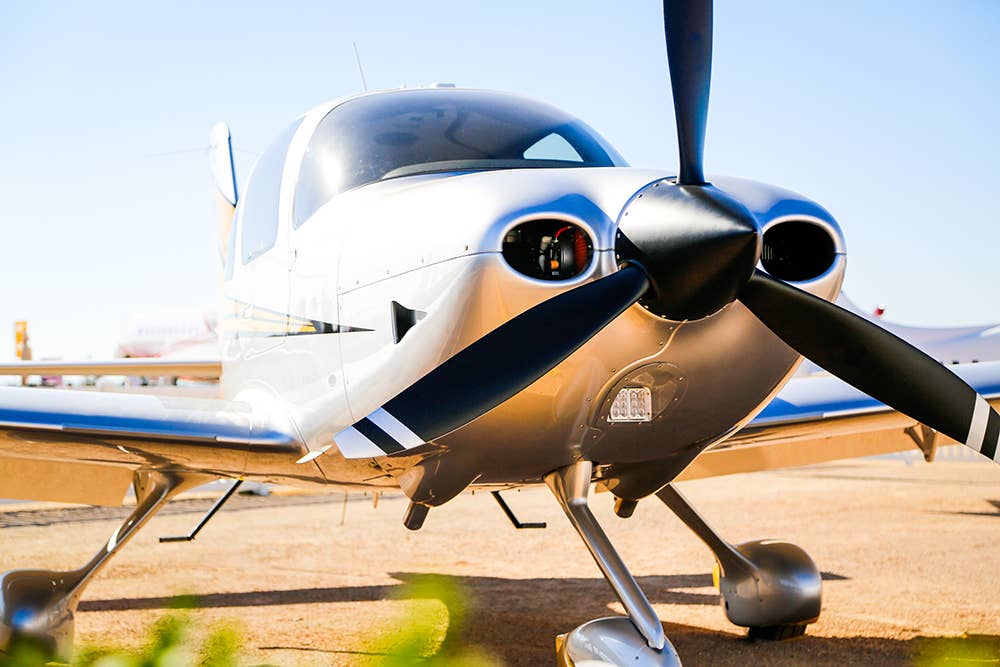Potential Crankshaft Flaw Prompts FAA To Issue Continental Engine AD
The airworthiness directive effectively grounds roughly 1,632 aircraft registered in the U.S. immediately, according to the FAA.

The FAA issued an airworthiness directive aimed at aircraft, such as Cirrus SR-22s, that are powered by certain piston engines manufactured by Continental Aerospace Technologies. [File Photo: Adobe Stock]
The FAA has issued an airworthiness directive aimed at aircraft powered by certain piston engines manufactured by Continental Aerospace Technologies. The AD—issued on the heels of a Continental Mandatory Service Bulletin (MSB23-01A) earlier this month—effectively grounds the aircraft until the directive, which focuses on the crankshaft counterweights, can be complied with.
The AD, published on February 23, calls for inspection of the crankshaft counterweight retaining ring within five hours for those new or rebuilt engines with less than 200 hours in operation since installation. Models include those in the 360, 470, 520, and 550 series.
These engines are used in a variety of aircraft, notably Beechcraft Barons, Bonanzas, and the Cirrus SR series.
Earlier this month Cirrus Aircraft reached out to SR22 owners and operators recommending precautionary grounding of the aircraft until the extent of the counterweight issue could be determined, and the American Bonanza Society sent an email warning about the service bulletin to its membership.
According to the AD, "It is possible that one or more counterweight retaining rings were not properly seated in the crankshaft counterweight groove of the engine. This condition could allow the counterweight to depart from the crankshaft during engine operation."
According to the AD, the improperly installed counterweight retaining rings "could result in ground engine seizures and an in-flight loss of engine oil pressure leading to catastrophic engine damage, engine seizure, and consequent loss of the aircraft."
By the Numbers
Per the published AD, "The manufacturer has notified the FAA that 2,176 crankshaft assemblies are subject to the unsafe condition. The FAA estimates that of those 2,176 crankshaft assemblies, 1,632 are installed on aircraft of U.S. registry. The FAA estimates that 544 engines will need to remove one cylinder, 544 engines will need to remove two cylinders, and 544 engines will need to remove three cylinders for compliance with this AD."
The FAA notes the cost of compliance is predicated on the time of inspection and number of cylinders that have to be removed, and ranges from approximately $64 for inspection to $1,870 for cylinder removal.
The AD notes the inspection must be completed prior to the next flight, and, tellingly, it does not provide a flight time allowance that can be used to reposition the aircraft to a maintenance facility.
Continental also published a notice of the AD on its website noting: "Please be aware that AD 2023-04-08 takes precedence over MSB23-01 making the AD the governing document and rule for this issue."
Continental is covering the cost of the inspection for the impacted engines, according to a representative from the company. People with questions can reach the company at 1-251-441-4460 (Monday through Friday, 6 a.m. – 6:30 p.m. CST) or by email, MSB23Support@continental.aero, This group can also help with warranty allowance processing or submitting the request for a gauge tool used during the inspection.
Acquiring a Ferry Permit
The FAA AD does allow for the issuance of a Special Flight Permit—also known as a ferry permit—to reposition an aircraft to a maintenance facility, provided that before the flight the engine oil filter pleats or screen are inspected, and there is no evidence of metal contamination, or an oil change has been completed within the previous five flight hours and there was no evidence of metal contamination in the oil filter pleats or screen.
How We Got Here
On February 9 Continental Aerospace issued a mandatory service bulletin (MSB23-01) calling for the precautionary grounding of the aircraft until there could be an inspection of the crankshaft counterweight retaining ring. According to the company, the service bulletin covered engines assembled between June 1, 2021, and February 7, 2023, and replacement crankshaft assemblies manufactured between June 1, 2021, through February 7, 2023.
According to the AD, the FAA determined an unsafe condition existed, making the AD urgent, which resulted in the AD being published in the Federal Register without the normal 30-day comment period.
On February 23 Cirrus notified owners and network partners providing them with links to their Authorized Service Center locator. The aircraft manufacturer also published a document noting the differences between the FAA-issued AD and the Mandatory Service Bulletin.
Differences Between the AD, Service Bulletin
·The FAA AD inspection requirements apply to all engines referenced in MSB23-01A regardless of the operating hours on the engine.
- The Continental Mandatory Service Bulletin excluded affected engines that had 200 or more operating hours (Hobbs time).
- The FAA AD must be completed prior to the next flight and does not provide a flight time allowance that can be used to reposition the aircraft to a maintenance facility, whereas the Continental Mandatory Service Bulletin allowed five hours to reposition the aircraft for compliance.
The FAA AD does allow for the issuance of a Special Flight Permit to reposition the aircraft to a maintenance facility, if certain actions are taken first:
- The engine oil filter pleats or screen are inspected and there is no evidence of metal contamination; or an oil change has been completed within the previous five flight hours and there was no evidence of metal contamination in the oil filter pleats or screen.

Subscribe to Our Newsletter
Get the latest FLYING stories delivered directly to your inbox






